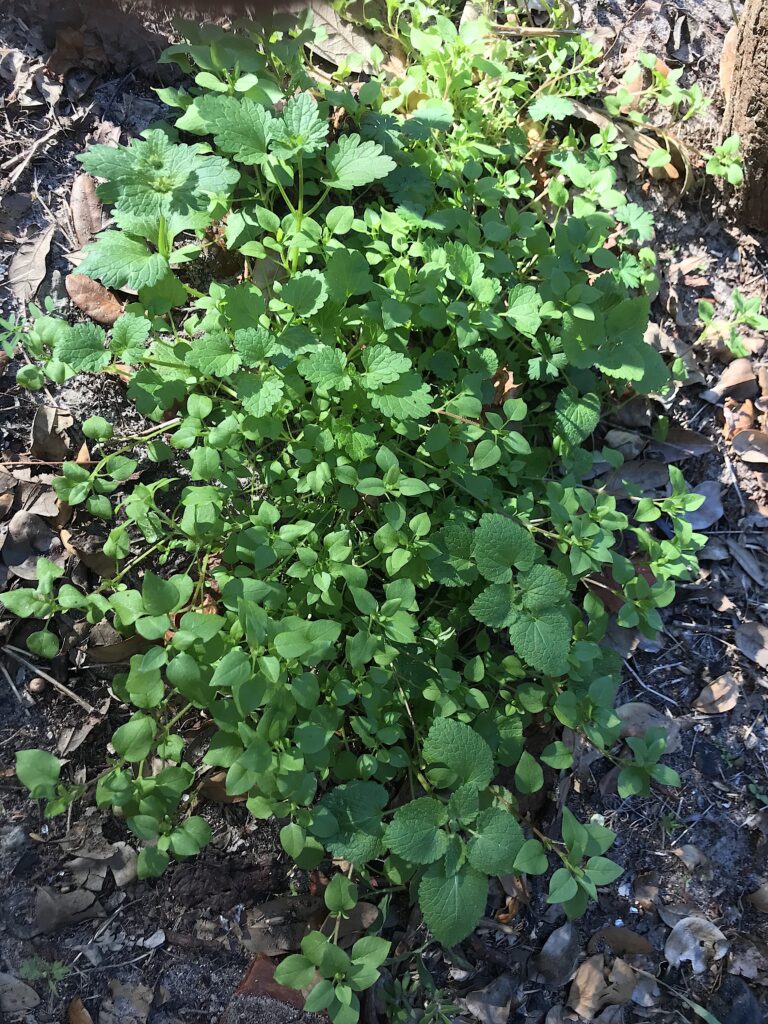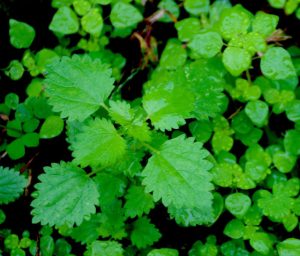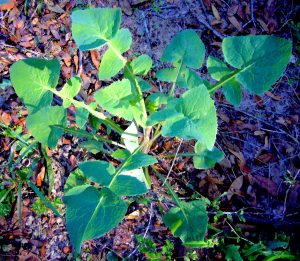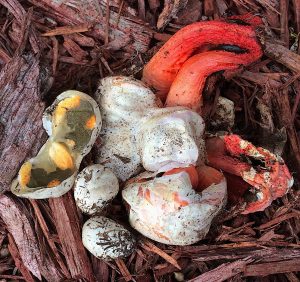
A Bunch of real chickweed and Hen bit, growing together. Photo by Green Deane
Seek and ye shall find. Thus far this year finding real chickweed (stellaria media) has been a challenge. Usually one spies it in late November, and now we’re mid-January. It and henbit have been elusive. Until this morning. Right outside my front door, there was a patch of chickweed with henbit tossed in. I didn’t plant them: They followed me home…
Both are edible raw. Henbit has a mild flavor, whereas raw chickweed tastes like corn silk or raw corn, which moderates on cooking. Henbit was a favorite springtime green of the natives because of it’s mild in flavor. Many springtime potherbs are in the mustard family and peppery to varying degrees.

Stinging Nettles are making their seasonal debut. Photo by Green Deane
Our mighty stinging nettles are up, we saw some in Largo Saturday. They’re one of the most popular wild edibles.The most powerful stinging nettle is in New Zealand (Urtica ferox) which kills animals and has claimed at least one human life. Our nettle, Urtica chamaedryoides, has a sting like a giant wasp and can burn for days or more. While its common name is a deceptive, “Heartleaf Nettle” its botanical name gets to the point, “Stinging Dwarf.” Quite edible but you must handle it with care. If this particular species stings me it is not only extremely painful but a bloody welt develops and the site is sensitive to temperature changes and any liquid for more than a week. The irritant compounds are histamines and acetocholines. Apparently I am quite sensitive to them though I can eat the plant raw or cooked (crushing the needles disarms them.) I like to dehydrate them next to a campfire. Also don’t confuse this plant with another stinging plant called the Spurge Nettle, Cnidoscolus stimulosus (video here ). That has an edible root but the leaves are usually not eaten. To learn more about the Heartleaf Nettle go here. For a video, here.

Common Sow Thistle. Photo by Green Deane
Another not unexpected seasonal green this weekend was the sighting of Sow Thistles. Like its relative the Dandelion it, too, prefers the cooler months locally. Not a true thistle it’s one of the more milder seasonal greens, and is slightly bitter. Although Sow Thistles are commonly called “thistles” they are not in the genus and do not draw blood with spines like true thistles. True thistles are well-armed with needle-sharp spines. While the Sow Thistle can look intimidating it’s mostly just show in that the spines are soft. There are two species locally, the Common Sow Thistle and the Spiny Sow Thistle. The latter is a bit rougher than the former but no where near as abusive as true thistles. Both are slightly bitter raw. A few minutes of boiling or steaming takes away the bitterness completely (unlike wild lettuce which always stays slightly bitter.) I have a video on the sow thistles and to read more about them go here.

Beach Bean Canavalia Rosea
We had a rare class at Princess Place Preserve in Palm Coast Sunday, thank you to everyone who turned out on that chilly morning. Princes Place Preserved is a good place to find chanterelles and black trumpet mushrooms when they are in season (around June.) A plant we did not see though I think we would if we looked around more is Beach Bean, Canavalia maritima (aka Rosea) The plant gets mixed reviews, eaten for a long time yet listed as toxic. The adult beans are definitely to be avoided but the young seeds are being eaten by humans somewhere as you read this paragraph, quite popular. There is no record of local natives using the C. Maritima for food, and among Caribbean people it is viewed as a medicine. Professor Daniel Austin, author of Florida Ethnobotany, writes that he flipped back and forth on edible or not. He avoided it than had studnets who ate it, then he ate them and later stopped. As many legume species develop lectins as they age that might be the issue with the Beach Bean and why they are edible young and not recommended when mature. Upcoming foraging classes are:

Classes are held rain or shine or cold. (Hurricanes are an exception.) Photo by Kelly Fagan.
Saturday January 21th, Bayshore Live Oak Park, Bayshore Drive. Port Charlotte, 9 a.m. meet at the parking lot at Bayshore and Ganyard street.
Sunday January 22nd, Red Bug Slough, 5200 S. Beneva Road, Sarasota. 9 a.m.
Saturday January 28th, Mead Garden: 1500 S. Denning Dr., Winter Park, FL 32789. Meet at the bathrooms. 9 a.m.
Sunday January 29th, Dreher Park, 1200 Southern Blvd., West Palm Beach, 33405. 9 a.m. meet north of the science center parking lot.
For more information, to pre-pay or sign up go here.

Stinkhorn Mushroom. Photo by Green Deane
Many cheeses have a strong aroma. My Father did not eat cheese ever. Mother likened cheese to dirty socks so she didn’t eat it either or mushrooms. Just as well. We have a very smelly mushroom which when young smells quite tasty but when past the juvenile stage smells like road kill. It’s the stink horn. There are many stink horns. This one is Clathrus columnatus. Opinions vary whether it is edible in the “egg” stage. I don’t conveniently see them that often in the “egg” stage to give them a try. Phallus ravenelii is definitely edible in the egg stage and has a flavor similar to radish.

Green Deane videos are now available on a USB.
My nine-DVD set of 135 videos has been phased out and replaced by 171-videos on a 128-GB USB, see right. The USB videos are the same videos I have on You Tube. Some people like to have their own copy especially if social order falters. The USB videos have to be copied to your computer to play. If you want to order the USB go to the DVD/USB order button on the top right of this page or click here. That will take you to an order form. Or you can make a $99 donation, which tells me it is for the USB (include a snail-mail address.) I’d like to thank all of you who ordered the DVD set over the years which required me to burn over 5,000 DVDs individually. I had to stop making them as few programs now will read the ISO files to copy them. Burning a set also took about three hours.

Green Deane Forum
Want to identify a plant? Perhaps you’re looking for a foraging reference? You might have a UFO, an Unidentified Flowering Object, you want identified. On the Green Deane Forum we — including Green Deane and others from around the world — chat about foraging all year. And it’s not just about warm-weather plants or just North American flora. Many nations share common weeds so there’s a lot to talk about. There’s also more than weeds. The reference section has information for foraging around the world. There are also articles on food preservation, and forgotten skills from making bows to fermenting food. Recent topics include: Stale Bread and Cod Liver Oil, Killing Bugs with Tobacco Plugs, Eating weeds: Is it safe? Have they mutated? Not the Eastern Red Bug but the Pink Tabebuia, African Tulip Tree, Asparagus densiflorus, Green Deane’s Book… You can join the forum by clicking on the button on the upper right hand side of this page.
This is my weekly newsletter #541. If you want to subscribe to this free newsletter you can find the sign-up form in the menu at the top of the page. My website, EatTheWeeds.com, which is data secure, has over 1500 plants on it in some 428 articles. I wrote every one myself, no cut and paste.
To donate to the Green Deane Newsletter click here.

